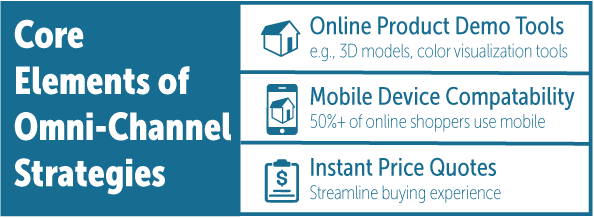Why build-to-order businesses should embrace omnichannel retail
by IdeaRoom Technologies, on Feb 17, 2022 11:09:26 AM
While “omnichannel retail” may sound like pretentious corporate jargon, it is important for any retailer to understand. Simply put, the term “omnichannel retail” refers to brands making their products available to consumers through multiple channels including physical stores, websites, and mobile devices.
Companies who offer customizable structures are recognizing the necessity of providing their customers with a robust online and mobile shopping experience. Over the past four years, IdeaRoom has helped over 300 companies implement an omnichannel strategy by adding interactive, configurable 3D designers to their websites.
This is a crucial step forward as consumers become more and more attached to online and mobile shopping. A recent study showed that 41% of Baby Boomers, 56% of Generation X, and 67% of Millennials prefer to shop online. With 50%+ of consumers wanting to do all or part of their shopping online, it is clear that every retail sector will need to adopt omnichannel retail strategies. Building companies are feeling pressure as they start seeing their regional and national competitors upgrading their online and mobile shopping platforms.
Omnichannel strategies are not one-size-fits-all. Every retail sector has unique requirements to be successful across multiple shopping channels. Building companies have several unique challenges including offering many custom features for customers to select (e.g., size, siding, accessories), complex pricing, and arranging delivery. The key to designing a successful omnichannel strategy for your company is to focus on the core goal of omnichannel retail: making the shopping experience more convenient for your customers. For building companies, this means providing your customers with virtual tools to help them understand and evaluate your many building options from any device.
Omnichannel strategies recognize that customers' shopping journeys will often involve interacting with the brand through multiple channels before the final purchase. For example, it is very common for consumers to research and evaluate brands online and on their mobile devices before visiting a physical store or making a phone call.
Here is a hypothetical example of how your customers' buying journey could progress with an omnichannel retail strategy:
Step 1, Product Awareness: Tom and Cindy just bought a house and want to add a shed to the backyard. Neither have ever purchased a shed before. One evening, while watching football on his couch, Tom starts Googling shed companies on his iPhone. He finds a local company with a mobile-friendly website and starts browsing the site. He finds they have a tool that lets him configure a 3D model of a shed from his phone. Tom starts playing with the 3D model. Using the shed configurator, he experiments with color combinations, adds and removes windows, and tries out a few different door styles. When he's happy with his shed, he tries it out in his backyard using an Augmented Reality viewer. It looks great against his landscaping!
Step 2, Consideration: After a few minutes, he has a shed he likes. He emails Cindy a copy of the shed. The next day, Cindy opens Tom's email while on her computer at work. She clicks on the link to the shed and starts making her own modifications. She upgrades the door, adds shutters and flower boxes, and finally adds a dormer. She emails a copy back to Tom. Tom looks at Cindy's changes on his iPad on the train after work. Despite the increased price for the accessories Cindy added, he has to admit, it is a really nice looking building.
Step 3, Purchase: Tom texts Cindy, "Ready to buy the shed?" Cindy responds, "Yes!" Tom submits the shed configuration to the shed company, indicating he is ready to buy. The next day, Tom's receives a call from the shed company. The sales person has the shed configuration Tom and Cindy submitted. In a five minute conversation, Tom and the sales person discuss site preparation, delivery times, and Tom pays his deposit. Tom and Cindy are thrilled with their experience and excited for their shed. The shed company got a high-value sale with minimal sales assistance.
As that hypothetical illustrates, in addition to making the shopping experience easier for customers, omnichannel strategies benefit build-to-order companies by increasing the number of sales completed with minimal sales person involvement. It truly is a win-win for customers and companies. In that hypothetical, the key was a mobile-friendly 3D shed configurator that allowed Tom and Cindy to easily understand the shed options and see how those options looked and impacted the price. Because the 3D configurator was mobile-friendly, it allowed Cindy and Tom to seamlessly shop when and how they preferred from any of their devices. The configurator even upsold the couple on additional decorative accessories. By adding that one feature to their website, the shed company effectively implemented a powerful omnichannel strategy.
While omnichannel strategies can be complicated—spanning multiple social media outlets and including technology to track customers' movements—build-to-order companies can benefit from implementing a basic omnichannel strategy that achieves its essential goals. Remember, the core goal of any omnichannel strategy is making the shopping experience more convenient for your customers. This can generally be achieved through three essential elements:
1. Online Product Demo Tools: Support online product browsing and research with online tools to allow customers to virtually evaluate your product.
2. Mobile Device Compatibility: Ensure your online presence is mobile compatible to capture the 50%+ of consumers shopping on mobile devices.
3. Instant Price Quotes: Provide instant price quotes to satisfy modern consumers’ expectations of the online buying experience and create a more efficient sales process for the build-to-order company.

IdeaRoom effectively creates an omnichannel strategy for shed, carport, post frame and red iron companies by allowing their customers to thoroughly evaluate the product and receive a quote, online and on mobile devices. Schedule a demo to learn more about how IdeaRoom can help you implement an omnichannel retail strategy for your business.




